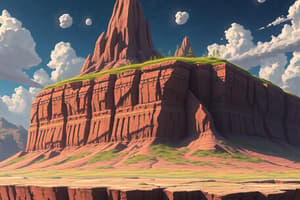Podcast
Questions and Answers
What are the primary components of the rock material on the surface of the continents?
What are the primary components of the rock material on the surface of the continents?
- Silica and Magnesium
- Silica and Alumina (correct)
- Magnesium and Iron
- Silica and Iron
Which rock is not used in the construction of the Red Fort?
Which rock is not used in the construction of the Red Fort?
- Limestone (correct)
- Marble
- Granite (correct)
- Sandstone
Which of the following describe minerals accurately?
Which of the following describe minerals accurately?
- Substances made artificially with definite physical properties
- Naturally occurring substances with physical properties but varied chemical composition
- Naturally occurring substances with definite chemical composition and physical properties (correct)
- Man-made substances with definite physical and chemical properties
Which type of rock is formed through the cooling and hardening of magma or lava?
Which type of rock is formed through the cooling and hardening of magma or lava?
Which of the following is an example of a sedimentary rock?
Which of the following is an example of a sedimentary rock?
To what depth does the mantle extend beneath the Earth's crust?
To what depth does the mantle extend beneath the Earth's crust?
Which of these rocks contain fossils?
Which of these rocks contain fossils?
What is a primary cause of physical weathering?
What is a primary cause of physical weathering?
Metamorphic rocks are primarily formed by which processes?
Metamorphic rocks are primarily formed by which processes?
Which type of weathering is caused by rainwater?
Which type of weathering is caused by rainwater?
Which of these materials can be classified as fuels?
Which of these materials can be classified as fuels?
Which term is used to describe the oceanic crust?
Which term is used to describe the oceanic crust?
What is the approximate thickness of the Earth's crust on the ocean floor?
What is the approximate thickness of the Earth's crust on the ocean floor?
What is the thinnest layer of the Earth?
What is the thinnest layer of the Earth?
What is a common characteristic of sedimentary rocks?
What is a common characteristic of sedimentary rocks?
What forms when metamorphic rocks melt and cool down?
What forms when metamorphic rocks melt and cool down?
Which of the following rocks is an example of an igneous rock?
Which of the following rocks is an example of an igneous rock?
Which type of rock is formed from molten magma?
Which type of rock is formed from molten magma?
What is not a method of transporting rock sediments?
What is not a method of transporting rock sediments?
Which layer of the Earth lies directly beneath the crust?
Which layer of the Earth lies directly beneath the crust?
Which is not a use of minerals?
Which is not a use of minerals?
What is a prominent feature of the continental mass?
What is a prominent feature of the continental mass?
Which process involves the breaking down of rocks into smaller pieces?
Which process involves the breaking down of rocks into smaller pieces?
Which of these does not contribute to physical weathering?
Which of these does not contribute to physical weathering?
Which rock is not an example of sedimentary rock?
Which rock is not an example of sedimentary rock?
Flashcards are hidden until you start studying
Study Notes
Structure of the Earth
- The Earth is composed of several layers, similar to an onion.
- The crust is the outermost layer, with a thickness of approximately 5km on the ocean floor.
- The crust is divided into continental crust (silica and alumina) and oceanic crust (silica and magnesium, also known as sima).
- Beneath the crust lies the mantle, extending up to 2900 km in depth.
Types of Rocks
- There are three main types of rocks: igneous, sedimentary, and metamorphic.
Igneous Rocks
- Formed from the cooling and hardening of magma/lava.
- Can be found on the Earth's surface or inside the Earth.
- Examples include granite and basalt.
Sedimentary Rocks
- Formed when sediments are compacted and cemented together.
- Sediments come from eroded rock fragments, mineral grains, and organic remains.
- Often found in layers.
- Examples include sandstone, limestone, and shale.
Metamorphic Rocks
- Formed when existing rocks are transformed by heat and pressure.
- Can be formed from both igneous and sedimentary rocks.
- Often have a layered structure.
- Examples include marble, slate, and gneiss.
Uses of Rocks
- Rocks are used in various ways, such as in the construction of buildings (e.g., the Taj Mahal and Red Fort).
- Rocks provide resources like minerals, fuels (e.g., coal, natural gas, and petroleum), and metals (e.g., iron, aluminum, gold, and uranium).
Weathering
- Weathering is the breaking down of rocks through physical and chemical processes.
- Physical weathering: temperature changes, plant growth, animal burrowing, wind erosion, and ice wedging.
- Chemical weathering: rainwater, acid rain, and oxidation of iron.
Rock Cycle
- The rock cycle describes the continuous formation and transformation of rocks.
- Rocks undergo weathering, sedimentation, metamorphism, and melting, eventually forming new rocks.
Studying That Suits You
Use AI to generate personalized quizzes and flashcards to suit your learning preferences.


